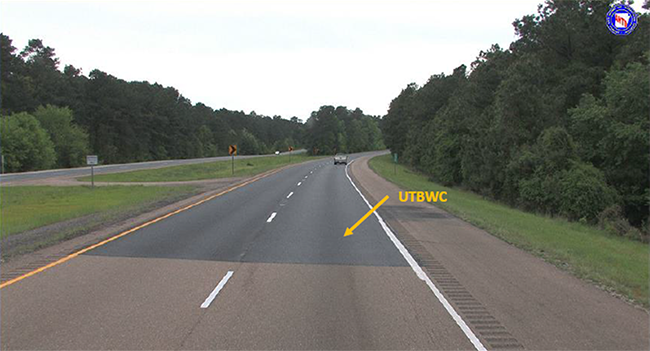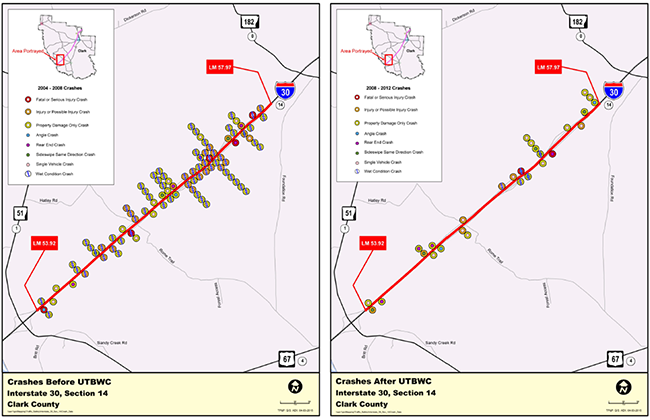What was the safety issue, problem, or gap?
Approximately 17 percent of all crashes from 2009 through 2011 that have occurred on Arkansas' highways were on wet pavement, resulting in 160 fatalities, or about 53 fatalities per year. One factor is the pavement, or more appropriately, the pavement texture. It can also have an impact on the ability of a vehicle, even with poor condition tires, to maintain contact with the surface, and the ability of the driver to maintain control of his or her vehicle. Of the 160 wet-weather fatalities that occurred from 2009 through 2011, 28 occurred on Arkansas' Interstates, or about 9 fatalities per year.
Arkansas made a previous effort to address roadway departure wet-weather crashes. The State identified several locations on the Interstate system with a high percentage of crashes due to wet pavement. Job 070322, Highway 51-Highway 182 Safety Improvements (S), was awarded in July 2008 and completed in November 2008. The purpose of this project was to overlay approximately four miles of Interstate 30 in Clark County. This project consisted of ultrathin bonded wearing course (UTBWC), cold milling, pavement marking, maintenance of traffic, and other miscellaneous items.
A before-after analysis was conducted within the job limits. In the 48 months prior to the improvement (November 1, 2004 to October 31, 2008), a total of 70 crashes due to wet pavement were observed. In the following 48 months after the project's substantial completion (November 1, 2008 to October 31, 2012), only 5 crashes occurred due to wet pavement. This is a significant reduction of about 93 percent. The benefit-cost ratio for this project is 2.98. Based on a literature review, this is similar to the results experienced in other states.
Describe the new practice.
Based on the previous success of the project on Interstate 30, the Arkansas Highway Commission passed Minute Order 2013-043 in April 2013. This Minute Order authorized the Department to proceed with pavement texture improvement projects to address wet pavement crashes on Arkansas Interstates. Six Interstate locations have been identified for possible UTBWC installation where a reconstruction project is not scheduled for construction within the next four years. Other treatment methods to improve pavement texture may be employed as well. Each of these locations has a high percentage of wet-weather crashes over the last three years.
Arkansas Highway Commission has authorized the Department to proceed with pavement texture improvement projects to address roadway departure wet-weather crashes on Arkansas Interstates.
The general key phases to the implementation of the UTBWC include:
- Cold milling,
- Pavement marking,
- Maintenance of traffic, and
- Other miscellaneous items.
List the key accomplishments that resulted from the new practice. Include the roadway safety improvements.
Installation of UTBWC has proven to be an effective low-cost countermeasure to improve skid resistance and reduce hydroplaning potential. In addition to the safety benefits, UTBWC preserves the existing pavement and improves user comfort. Due to the treatment's success, the Arkansas Highway Commission has authorized the Department to proceed with pavement texture improvement projects to address roadway departure wet-weather crashes on Arkansas Interstates. Six other locations with a high percentage of wet-weather crashes between 2009 and 2011 were identified. Addressing these locations with UTBWC will help reduce wet-weather roadway departure crashes, helping the Arkansas Highway State Transit Department fulfill its mission statement and strategic goals, and help Arkansas get one step closer Toward Zero Deaths.
What benefits were realized as a result of the practice?
- Significant reduction in wet weather crashes.
- UTBWC preserves the existing pavement and improves user comfort.
Further Reading
- Brewer,A., & D. Nilles. Improving Interstate Safety with Pavement Surface Treatments. Arkansas Highways Magazine, July, 2013. Pages 10-11.
- Oman, N. I-30 job targets rain-tied crashes Accidents drop in resurface test. Arkansas Democrat-Gazette. Front Section. Page 1.

Figure 1. Interstate 30 Westbound (Log mile 58.00) in Clark County
Study Area Crash Map

Figure 2. Study area crash map with before treatment crashes on left and after treatment crashes on right.
